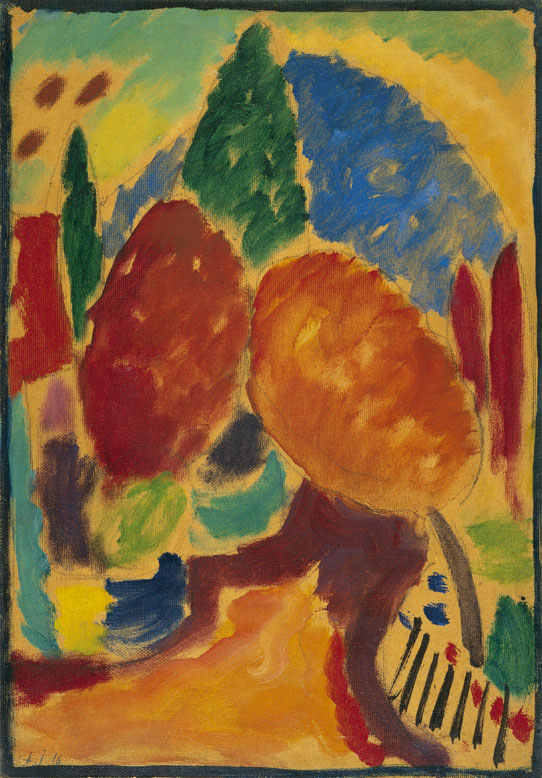Alexej von Jawlensky - The Orange Path
The Orange Path, 1916
Öl und Kohle auf leinenstrukturiertem Malkarton
37,5 x 26 cm
Stiftung Im Obersteg, Depositum im Kunstmuseum Basel
Inv. Im 1254
Zurzeit nicht ausgestellt
This picture was painted in Saint-Prex on Lake Geneva, where Jawlensky had moved in 1914, after the outbreak of the First World War. It is one in a series of Variations on a Landscape Theme that marks his fresh start as an artist after the relocation to Switzerland. The change of scenery—from Munich, a bustling large city, to the provincial lakeside village—led to a retreat both from social life and from earlier creative pursuits. For the next several years, Jawlensky painted by the window of his apartment, which overlooked a garden with tall firs, chestnuts, and poplars. The result was a series of over 600 variations of this unchanging motif in different atmospheric conditions and moods throughout the seasons. The repetitive process became Jawlensky’s novel artistic conception, guiding him to the edge of abstraction. He created compositions in ingeniously modulated poetic combinations of hues that he called “Songs without Words.” The depiction of the motif in The Orange Path is still fairly true to nature. We can clearly identify the garden scenery. In other works from the series, the treetops and shrubs take on lives of their own as impromptu colorful forms that the artist can recombine again and again as in a kaleidoscope to achieve fresh effects.
Provenance
Acquired in 1968 from the estate of the artist Karl Im Obersteg
Literature
Jawlensky 1991/1998
Maria Jawlensky, Lucia Pieroni-Jawlensky, Angelica Jawlensky: Alexej von Jawlensky. Catalogue Raisonné, 4 Bde., London: Sotheby's Publications 1991-1998, Bd. 2, S. 147, Nr. 788, Abb. S. 103
Baumgartner/von Tavel 1995
Michael Baumgartner und Hans Christoph von Tavel: Die Sammlung Karl und Jürg Im Obersteg, hrsg. von der Stiftung «Sammlung Karl und Jürg Im Obersteg», Bern, Bern: Benteli Verlag, 1995, S. 105-106, 110, Nr. 57, Abb.
Exhibitions
Basel 2004
Die Sammlung Im Obersteg im Kunstmuseum Basel. Picasso, Chagall, Jawlensky, Soutine, Kunstmuseum Basel, 14. Febr.-2. Mai 2004, hrsg. von der Stiftung Im Obersteg, Basel: Schwabe Verlag, 2004, Nr. 101
